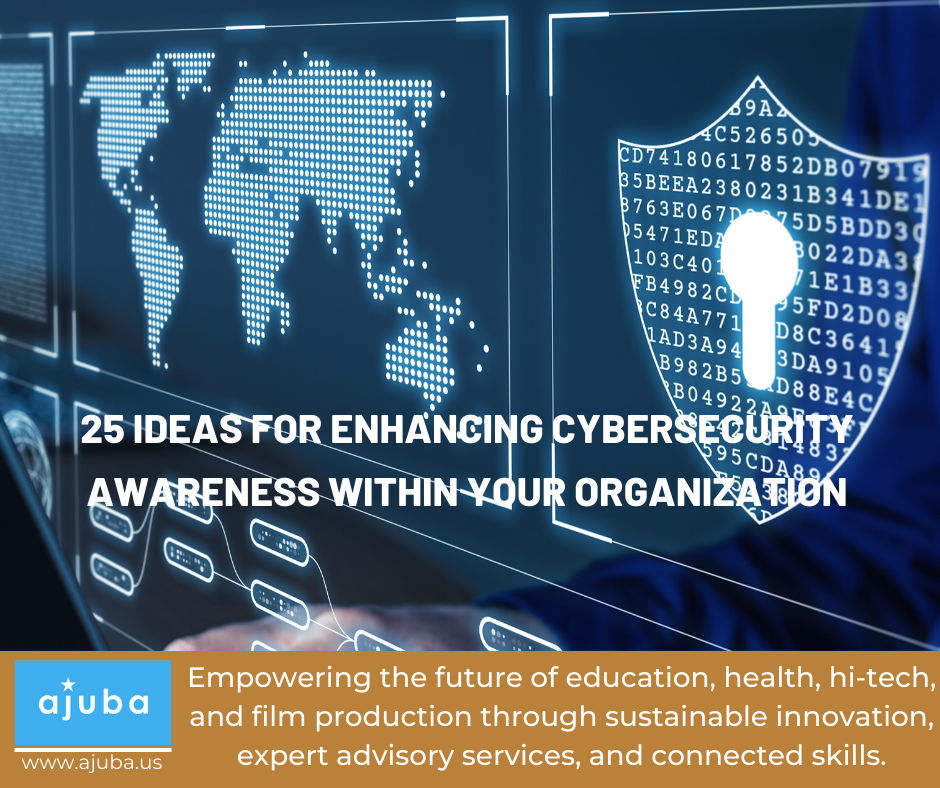Article #18
Cybersecurity awareness is a critical aspect of safeguarding an organization’s digital assets, privacy, and reputation. As we observe Cybersecurity Awareness Month in October, it becomes imperative to emphasize the importance of cybersecurity within organizations. Cyber threats are continually evolving, and the human factor remains one of the weakest links in the cybersecurity chain. To mitigate these threats effectively, organizations must foster a culture of cybersecurity consciousness among their employees.
Watch Webinar: Creating Cybersecurity Awareness in Your Organization
Guest Speaker: Osvaldo Rivera, Lead Impact Facilitator with ThriveDX
Cybersecurity awareness is an ongoing effort. Combining multiple approaches, such as training, communication, and practical exercises, helps reinforce the importance of cybersecurity in the workplace and empowers employees to be vigilant against cyber threats. Here are several ideas to help raise awareness among employees and promote a cybersecurity-conscious culture:
1. Cybersecurity Training Programs:
- Conduct regular cybersecurity training sessions for employees at all levels. These sessions should cover basic security practices, the latest threats, and safe online behavior.
- Offer advanced training for IT and security personnel to keep them up to date with emerging threats and security best practices.
2. Phishing Simulation Exercises:
- Run simulated phishing campaigns to test employees’ susceptibility to phishing attacks.
- Provide immediate feedback and training to those who fall for these simulations.
3. Security Awareness Campaigns:
- Launch ongoing awareness campaigns using various media, including posters, emails, newsletters, and intranet portals. These campaigns can highlight real-world examples of cyber threats and best practices.
- Use catchy slogans and branding to make cybersecurity awareness memorable.
4. Regular Security Updates:
- Keep employees informed about the latest security updates, patches, and software vulnerabilities. Encourage them to install updates promptly.
- Use email or notifications on company devices to remind employees of necessary updates.
5. Password Hygiene Guidelines:
- Promote strong password practices, such as using complex passwords, enabling multi-factor authentication (MFA), and not sharing passwords.
- Encourage regular password changes and provide guidance on creating secure passwords.
6. Cybersecurity Policies and Guidelines:
- Develop and communicate clear cybersecurity policies and guidelines. Ensure that employees understand their responsibilities regarding data security.
- Provide examples of acceptable and unacceptable behavior to illustrate policy compliance.
7. Employee Recognition and Rewards:
- Establish an employee recognition program that rewards individuals or teams for outstanding cybersecurity practices or reporting security incidents promptly.
8. Incident Reporting Channels:
- Make it easy for employees to report security incidents or suspicious activities. Provide clear instructions on how to report and assure them that reporting will not result in punitive action.
9. Tabletop Exercises:
- Conduct cybersecurity tabletop exercises or drills that simulate various cyber incidents. These exercises help employees understand their roles and responsibilities during a security incident.
10. Secure Remote Work Training:
- With the rise of remote work, provide training on secure remote work practices. This should cover topics like VPN usage, secure Wi-Fi, and secure file sharing.
11. Access Control and Least Privilege:
- Implement the principle of least privilege (PoLP) to restrict access to sensitive data and systems.
- Educate employees on the importance of accessing only what is necessary for their roles.
12. Regular Security Updates:
- Share news and updates on recent cyber threats, data breaches, and industry trends with employees. This keeps them informed about the evolving threat landscape.
13. Secure App and Device Usage:
- Educate employees about the risks of downloading apps from untrusted sources and using personal devices for work. Emphasize the importance of using company-approved software and devices.
14. Board-Level Support:
- Secure support from the board and executive leadership to prioritize cybersecurity awareness and allocate resources for training and security measures.
15. Feedback Mechanism:
- Establish a feedback mechanism where employees can provide suggestions or report security concerns. Act on this feedback to continually improve cybersecurity practices.
16. Regular Security Drills:
- Conduct cybersecurity incident response drills or tabletop exercises regularly. This helps employees practice their roles in responding to security incidents and reinforces the importance of preparedness.
17. Secure File Sharing Practices:
- Provide guidelines on secure file sharing, including the use of encrypted file-sharing platforms and the avoidance of sharing sensitive information via unsecured channels like personal email.
18. Social Engineering Awareness:
- Educate employees about common social engineering techniques, such as phishing, pretexting, and tailgating. Teach them to recognize and report suspicious interactions.
19. Mobile Device Security:
- Offer guidance on securing mobile devices, including smartphones and tablets. Encourage employees to enable device encryption, use screen locks, and install security updates regularly.
20. Employee Cybersecurity Pledge:
- Ask employees to commit to a cybersecurity pledge or code of conduct. This reinforces their personal responsibility for maintaining a secure workplace.
21. Red Team vs. Blue Team Exercises:
- Organize “Red Team vs. Blue Team” exercises where one group simulates attackers (Red Team) and the other defends against them (Blue Team). These exercises provide hands-on experience in identifying and countering threats.
22. Cybersecurity Awareness Champions Network:
- Establish a network of cybersecurity champions across different departments or teams. These champions can serve as peer educators and promote best practices within their groups.
23. Threat Intelligence Sharing:
- Encourage employees to share cybersecurity threat intelligence, such as suspicious emails or incidents they have encountered. This information can help the organization stay ahead of emerging threats.
24. Cybersecurity FAQ Repository:
- Create a repository of frequently asked questions (FAQs) related to cybersecurity. Make it accessible to employees for quick reference when they have security-related queries.
25. Cybersecurity Metrics and Reporting:
- Regularly share cybersecurity metrics and reports with employees, highlighting the organization’s security posture, ongoing initiatives, and areas for improvement.
By implementing these ideas, organizations can foster a cybersecurity-conscious culture where employees are active participants in defending against cyber threats. Remember that cybersecurity awareness is an ongoing effort. Combining multiple approaches, such as training, communication, and practical exercises, helps reinforce the importance of cybersecurity in the workplace and empowers employees to be vigilant against cyber threats.
Do you have any further ideas, please share with us! Email me at [email protected]

Baljit Singh is an accomplished Founder & CEO with a proven track record in building successful businesses in manufacturing and services companies. With expertise in leadership and general management, Baljit has developed and implemented business strategies, led sales and marketing functions, and built motivated teams in turn-around environments. Author of the Book, “My Experiments with Innovation,” he is a motivational speaker and gives talks on how to cultivate habits and change lifestyle to drive innovation. Baljit is currently driving cross border partnership between India-Israel-North America.
Website: www.ajuba.us
Email: [email protected]
